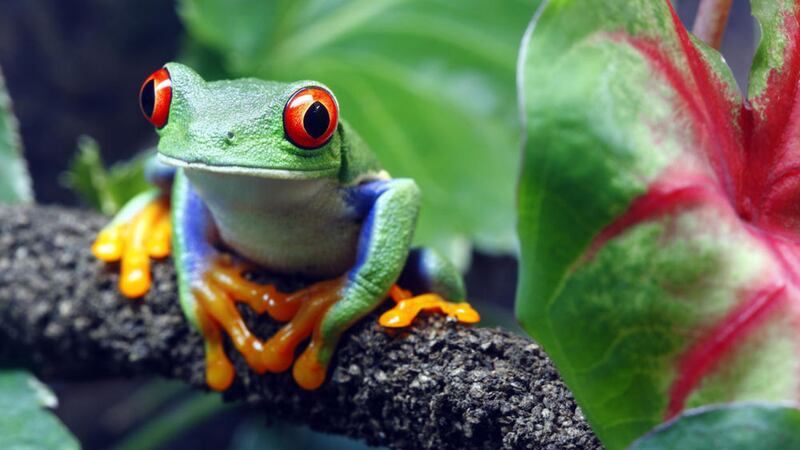FIRST day in Costa Rica and I see the kind of wildlife not on my bucket list, a tarantula-eating hawk wasp, but life can only get better when, within minutes, a flamboyant blue morpho, one of the largest butterflies in the world, glides past going nowhere.
Even more eye-dazzling is the birdlife teeming around – toucans with multicoloured bills, exquisite turquoise-browed motmots, iridescent humming birds – a rainbow of colours that greets you every day.
The biodiversity is extraordinary, safeguarded by conservation laws and programmes, spread across 26 national parks that make up 25 per cent of the Central American state’s total land mass.
The country is tiny, squeezed between the Pacific and Atlantic oceans, but ecologically it expands to include cloud forest, beaches and volcanoes. Your itinerary must take account of journey times on the roads and one tip is to skip the capital, San Jose, where there is little of interest, and head for a national park as soon as you arrive.
In four hours you could be in La Fortuna and hopping off to take one of the short trails through Volcán Arenal. This place was unvisited until the volcano exploded in 1968 and four decades of rumblings, smoke, steam and detonations followed until all went quiet in 2011.
Rincón de la Vieja, half a day away by road, has more to see by way of fumeroles and volcanic mud pools. Head further north east in this region, Guanacaste, and there is great walking and grand beaches on the Pacific coast. The landscape is green during the rainy season but bone dry the rest of the year.
Monteverde, once just a small Quaker settlement, is an epicentre of Costa Rican tourism. Activities abound – from adrenaline-pumping zip-lining to trekking, yoga and horseriding – with a visit to the Cloud Forest Reserve being the big draw. Some 13km of marked trails and birdlife galore, showcased by the resplendent quetzal, but at times it feels as crowded as a busy shopping mall.
One escape route is to head south to the coast for Carara national park – a home for the ultra-splendid scarlet macaw – and a river boat ride along the Tarcoles River. Getting close to the crocodiles is much touted but the richness of riverside bird life will be more absorbing for many.
If you want beaches and ocean sunsets as well as eco-walks through rainforests, the Manuel Antonio national park is a celebrated destination. The trails are easy to walk, the wildlife promiscuous and a picnic under palm trees after a swim in the turquoise Pacific is everything you could wish for. The only problem is that everyone with the same wish may also be here.
Keep heading south down the coast for the tranquillity that comes with empty beaches, though the rapidly developing surfing town of Dominical suggests the changes that are coming. For now, though, the nearby Hacienda Barú Wildlife Reserve remains a gem of a place, if only because there’s a good chance of seeing a three-toed sloth lazily moving a few inches before returning to sleep. Here too is an orchid garden, almond, noni and coca trees (book chocolate tours a day ahead).
Accommodation runs the gamut, from hostels to five-star establishments, and prices change with the seasons. I realised, after booking in elsewhere, that La Cusinga Lodge (lacusingalodge.com) is one of the best places to stay on the Pacific coastline: 10 teakwood cabins, half an hour from a beach, yoga classes, spa, whale and dolphin trips, nature tours, kayaking.
The journey from the airport takes three hours but you’re well away from the tourist traps and one of the country’s best national parks, Corcovado, is waiting for you further to the south.
Famously described by National Geographic as "the most biologically intense place on earth", Corcovado is a rainforest wilderness on a peninsula in the extreme south of Costa Rica. Coastal trails keep the sea in sight but your eyes will be distracted by the birdlife – vivid streams of coloured light guaranteed to astonish – and the mammals you will certainly see: white-faced capuchin monkeys are common, as are tapirs and agouti in the forest.
Make no mistake, though, trekking in Corcovado is the real deal and accommodation is not of the luxurious kind; in return you’ll have a wildlife experience like no other.
The window of opportunity for comfortably enjoying the wonderland of Costa Rica is narrow: late April/early May or early in December is best. In the wet season from June to mid-November the mornings are still sunny though rain comes in the afternoons. The rest of the year expect sunny days and high temperatures but from mid-December to Easter visitor numbers swell and popular places become expensive and overcrowded.
The trick to making your holiday a tropical paradise is choose carefully when you go and where. Consider skipping the better-known places and don’t plan to criss-cross the country because travelling in Costa Rica always takes far longer than you think. Pura vida (the pure life) has become a national motto but you won’t see Costa Ricans rushing about in search of it.
The macaws and toucans like hanging out in the branches of trees and the three-toed sloths spend eighty per cent of their lives sleeping.
WILDLIFE
With some 900 species of bird, 250 species of mammal and a mindboggling variety of plant life, there is plenty to see but you need to come prepared with a pair of binoculars and a couple of guide books.
Birds of Costa Rica by Garrigues and Dean will help you identify the toucans and parrots, the humming birds and herons, while Tropical Plants of Costa Rica by Zuchowski keeps to the common and conspicuous flowering trees, fruit and exotica that colour the landscape.
The best national park for wildlife is Corcovado and, for a niche eco holiday, a case could be made for slowly travelling down the Pacific coastline in the south and staying on the Peninsula de Osa.
FACT FILE
Tours Birdwatching, night walks, canopy tours, horse-riding in Monteverde and Arenal: costaricanaturalista.com.
Nature tours, night walks and bicycle tours at San Antonio: hotelparador.com/tours. Birds and crocodiles at Tarcoles: junglecrocodilesafari.com; Wildlife Refuge at Dominical; haciendabaru.com.
Artisanal and medicinal plant tours near Dominical: ronaldalpizar24@gmail.com; trekking in Corcovado osawildtravel.com.
A guide book is essential for planning a trip and Rough Guide’s Costa Rica has the lowdown on where to go and stay. Freytag & Berndt’s Costa Rica map has all the road numbers and useful tourist information marked.
Re money: Just bring US dollars, also available from ATMs, as they are accepted everywhere and the Costa Rican currency, the colon, will often be given in change and can be used where prices in dollars are not quoted. Costa Rica is not cheap and all the national parks have entrance fees; expect to pay £40 for a three-course meal and a bottle of wine.



